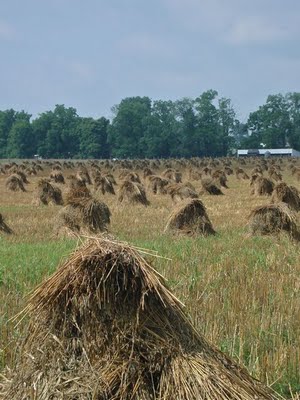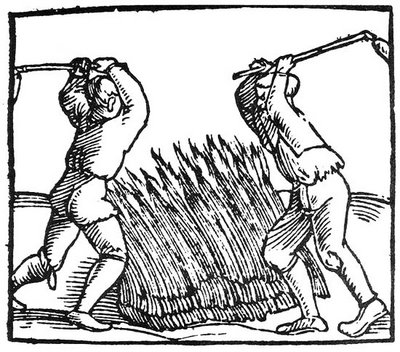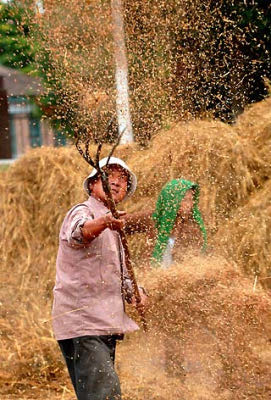
Harvesting, threshing, winnowing, and dehulling backyard grains
 Now
that you've got an idea of which
grains to try growing in your backyard
and how
much space you need to grow the grains, let's talk about the
actual growing process. Most of grain-growing is pretty similar
to growing anything else. Some grains are planted in the spring
and others in the fall, then you weed them and hope that bugs and
diseases don't do much damage.
Now
that you've got an idea of which
grains to try growing in your backyard
and how
much space you need to grow the grains, let's talk about the
actual growing process. Most of grain-growing is pretty similar
to growing anything else. Some grains are planted in the spring
and others in the fall, then you weed them and hope that bugs and
diseases don't do much damage.
One major difference
between grains and vegetables is that grains are traditionally planted
in solid blocks in America rather than rows. Commercial farmers
depend on heavy applications of herbicides to keep these fields of
grain weed-free, but Logsdon suggests that the American farmer might be
better off using the Chinese method of planting in rows so that your
grains can be hand-weeded. Alternatively, you might rotate your
grains after a crop that's cultivated intensely for weeds like
strawberries or potatoes.
The main differences
between growing grains and vegetables, of course, come during the
harvest. On the backyard scale, most grains are harvested by
cutting the whole plant down with a scythe when the seeds are mostly or
fully mature. You can tie plants into bundles and then into
shocks to dry in the field, or bring them under cover and let them dry
inside. Either way, in a couple of weeks once the plants are
fully dry, it's time to separate the seeds from the head.

The first step is
threshing --- lay the plants down on a big bedsheet on a flat surface
and whack the daylights of out them with a bat or stick.
Alternatively, beans can be threshed by putting the whole plants in a
bag and beating the bag around. When you're done threshing, the
seeds should have fallen out and you can take away the bulk of the
plants for the chickens to peck through and then to be used as mulch.
 Of course, a lot of bits of
chaff (excess plant matter) end up in with the seeds after threshing,
so the next step is winnowing --- removing the grain from the
chaff. Logsdon advocates pouring the grain and chaff mixture from
one bucket to another, either outside where a breeze can pull away the
chaff or in front of a big fan. In either case, you will need to
pour each bucket of grain six to ten times to end up with clean seeds.
Of course, a lot of bits of
chaff (excess plant matter) end up in with the seeds after threshing,
so the next step is winnowing --- removing the grain from the
chaff. Logsdon advocates pouring the grain and chaff mixture from
one bucket to another, either outside where a breeze can pull away the
chaff or in front of a big fan. In either case, you will need to
pour each bucket of grain six to ten times to end up with clean seeds.
If you're working with
wheat or some other grains, you are now done with the grain separation
steps, but oats, barley, buckwheat, and rice all need to be
dehulled. These seeds are coated in a tough substance that won't
be very tasty, and which is, unfortunately, hard to remove effectively
at the home scale. Logsdon suggests heating the grains at 180
degrees Fahrenheit for an hour and a half, putting them through a
blender, then sifting out the hulls, but he admits his method is only
moderately effective. Southern
Exposure Seed Exchange has instructions for turning your grain mill
into a dehuller,
which might be worth a shot. Or just grow hull-less oats and feed
hull-covered grains to your livestock.
| This post is part of our Backyard Grain Growing lunchtime series.
Read all of the entries: |
Want more in-depth information? Browse through our books.
Or explore more posts by date or by subject.
About us: Anna Hess and Mark Hamilton spent over a decade living self-sufficiently in the mountains of Virginia before moving north to start over from scratch in the foothills of Ohio. They've experimented with permaculture, no-till gardening, trailersteading, home-based microbusinesses and much more, writing about their adventures in both blogs and books.
Want to be notified when new comments are posted on this page? Click on the RSS button after you add a comment to subscribe to the comment feed, or simply check the box beside "email replies to me" while writing your comment.
- Remove comment
